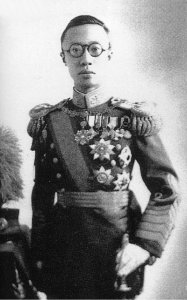
as the Kangde Emperor
of Manchu-kuo
| HOME | CONTENTS | BACK | NEXT |
|---|
 as the Kangde Emperor of Manchu-kuo |
He was sent to the Fushun Prison in 1950 by the Chinese Communist Party as a "war criminal" who revolted against China as the Emperor of a puppet state of Japan, Manchu-kuo (滿洲國; Manchu Country; 1932-45)[2] to oppress Chinese people. He was re-educated in a "thought-reform" program and was released from the Prison under a special amnesty in 1959. However, there is a suspicion on the accusation whether he was really a "traitor to China."
He was born in 1906 as a member of the Imperial Family of the Ch'ing Dynasty (淸 1644-1912; Pinyin: Qing).[3] He was enthroned as the last Emperor of the Ch'ing Dynasty (reign title: Kangde Emperor 宣統帝) at the age of three by the Empress Dowager T'zuhsi (西太后; Pinyin: Cixi; 1835-1908).[4] But he was forced to abdicate in 1912 at the age of six following the Hsinhai Revolution (辛亥革命; Pinyin: Xinhai)[5] led by Sun Wen (孫文; Sun Yat-sen 孫逸仙; or Sun Chung-shan 孫中山)[6] as the Ch'ing Dynasty ended. He was expelled from the Forbidden City (紫禁城; Tzuchin Castle; Pinyin: Zijin) and drifted through the Japanese Legation and the T'ienchin Foreign Settlement (天津租界; Pinyin: Tianjin). After the Manchurian Incident (滿洲事變; or Mukden Incident 奉天事變; Chinese: September 18 Incident 九一八事變; 1931),[7] he was installed by the Japanese army to Hsinching (新京; Pinyin: Xinjing; curt. Changchun 長春) as the ruler (Head of State) of Manchu-kuo. In 1934, he was officially crowned the emperor of Manchu-kuo under the reign title Kangde again in 1912. So far, there is no basis to judge whether he was a "war criminal." Here, the key word to elucidate this question is "Manchu-kuo."
Manchu-kuo is an empire existed in Manchuria[8] (currently called Northeast China) during the wartime. China calls Manchu-kuo as the "False Manchu-kuo" (僞滿洲國) as a puppet country that was established by "dividing the country China." However, China's assertion seems rather false. The clues for the right answer will be found when we thoroughly review the history of "Manchu-kuo."
Manchurian tribes used to be called Mishihase (肅愼; Chinese: Sushen)[9] or Jurchens (女眞 or 女直)[10] in the ancient time. Since the medieval period, there were many rises and falls of nations of northern ethnic groups in the area such as Moho (靺鞨; Pinyin: Mohe; Korean: Malgal),[11] Bolhae (渤海; Chinese: Pohai/Bohai; 698-926)[12] Liao Dynasty (遼; 907-1125)[13] and Chin Dynasty (金; Pinyin: Jin; 1115-1234).[14]
The first time when both of Manchuria and China were ruled under the same empire was during the Yuan Dynasty (元; 1271-1368).[15] But it does not mean that Manchuria was "annexed to China" because the Yuan is the Mongol Empire. In fact, China was ruled by the Mongolian Yuan Dynasty during the period. Manchuria was also ruled by the Mongolian people but not by Chinese. During the Ming Dynasty (明; 1368-1644)[16] period, Manchuria was under political and military influences of the Ming (a Chinese empire) but was not under its rule. In the 17th century, the rise of the Manchu Dynasty Ch'ing came to rule whole China.
Ch'ing Dynasty was established in 1616 as a united Manchuria by Nurhaci (弩爾哈斉;1558-1626)[17] who was the king of a tribe in the area called Chienchou Jurchens (建州女直; Pinyin: Jianzhou).[18] During the reign of the second emperor Hung Taiji (皇太極; 1592-1643)[19], the Ch'ing Dynasty annexed Mongolia to the Manchu empire. The third emperor Shunchih (順治; Pinyin Shunzi; 1638-1661?)[20] started conquerring China. And during the period of the fourth emperor K'anghsi (康煕; Pinyin: Kangxi; 1654-1722),[21] Ch'ing Dynasty concuered the whole China. The Ch'ing Dynasty until the Last Emperor P'ui was therefore a country, the Manchu Empire ruling China. It means that China practically "recovered its sovereignty" from the Manchu ruler when the Ch'ing Dynasty collapsed in the revolution by the Chinese.
After the fall of the Ch'ing Dynasty, the Last Emperor established Manchu-kuo through ups and downs of life over years. Up to this point, I guess that you are already clear about the fact. The Last Emperor just established a country in his ancestral homeland Manchuria. Since the ancient time, Manchuria had never been occupied by the Chinese. Therefore, China's accusations "dividing China" and "oppressing the Chinese people" are totally incorrect so the Last Emperor was falsely accused. In fact, China just took advantage of the confusion after the war to annex Manchuria as the "Northeast China." It was definitely China's outrageous invasion and is nothing different from the case of Japan's Chishima Islands (千島列島; Russian: Kuril Islands)[22] that have been occupied by the Soviet Union (curt. Russia)
Related information (Links)
| HOME | CONTENTS | BACK | NEXT |
|---|